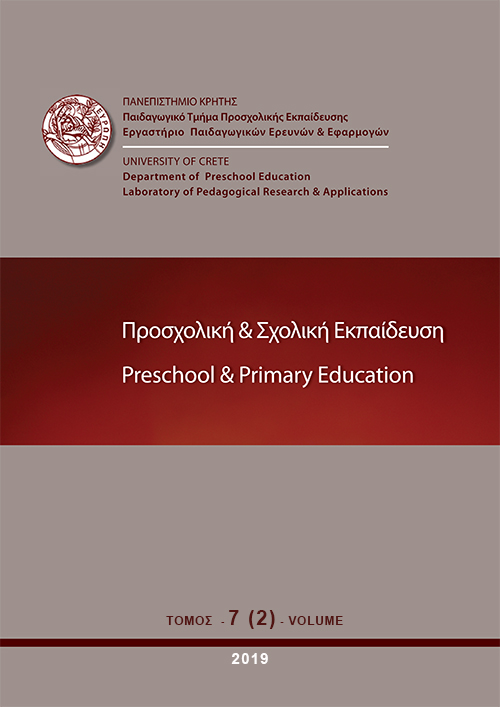Four Job Satisfaction’s dimensions of secondary education teachers: An Exploratory Factor Analysis based on a Greek sample
Περίληψη
Background
Surveying and assessing teachers’ job satisfaction constitutes an evergreen crosscutting issue. It deploys the formation of policies that underpin its’ augmentation aiming for enhanced educational outcomes. Internationally there are not many valid instruments that can be used to assess teachers’ job satisfaction. Especially in Greece, research on the reliability and validity of these instruments when applied on teachers is non-existent.
Method
The instrument used was JSS. JSS describes nine (9) dimensions of Job Satisfaction. 177 secondary education teachers in Western Greece took part in this research. Exploratory Factor Analyses was conducted.
Results
Parallel analyses and principal axis factoring revealed a structure of 4 dimensions of the JSS. Confirmatory factor analysis ascertained this structure that features satisfactory reliability and construct validity.
Conclusions
We could say that the JSS, according to the factorial structure, could be considered an appropriate tool for investigating the JS of teachers in Greece as well. The four -dimensions of the JSS revealed by the answers of Greek secondary education teachers are: teachers’ Payment framework, teachers’ Supervision, Nature of work and teachers’ Communication.
Λεπτομέρειες άρθρου
- Πώς να δημιουργήσετε Αναφορές
-
Lavidas, K., Dalapa, M., Dimitriadou, S., & Athanassopoulos, S. (2019). Four Job Satisfaction’s dimensions of secondary education teachers: An Exploratory Factor Analysis based on a Greek sample. Preschool and Primary Education, 7(2), 102–115. https://doi.org/10.12681/ppej.20412
- Τεύχος
- Τόμ. 7 Αρ. 2 (2019)
- Ενότητα
- Άρθρα

Αυτή η εργασία είναι αδειοδοτημένη υπό το CC Αναφορά Δημιουργού – Μη Εμπορική Χρήση – Παρόμοια Διανομή 4.0.
Οι συγγραφείς των άρθρων που δημοσιεύονται στο ΠΡΟΣΧΟΛΙΚΗ & ΣΧΟΛΙΚΗ ΕΚΠΑΙΔΕΥΣΗ διατηρούν τα δικαιώματα πνευματικής ιδιοκτησίας επί των άρθρων τους, δίνοντας στο περιοδικό το δικαίωμα της πρώτης δημοσίευσης. Άρθρα που δημοσιεύονται στο ΠΡΟΣΧΟΛΙΚΗ & ΣΧΟΛΙΚΗ ΕΚΠΑΙΔΕΥΣΗ διατίθενται με άδεια Creative Commons 3.0 και σύμφωνα με την άδεια μπορούν να χρησιμοποιούνται ελεύθερα, με αναφορά στο/στη συγγραφέα και στην πρώτη δημοσίευση για μη κερδοσκοπικούς σκοπούς και με δικαίωμα τροποποίησης μόνον με παρόμοια διανομή (αν αναμείξετε, τροποποιήσετε, ή δημιουργήσετε πάνω στο υλικό, πρέπει να διανείμετε τις δικές σας συνεισφορές υπό την ίδια άδεια όπως και το πρωτότυπο). To Εργαστήριο Παιδαγωγικών Ερευνών και Εφαρμογών του Παιδαγωγικού Τμήματος Προσχολικής Εκπαίδευσης του Πανεπιστημίου Κρήτης και το Εθνικό Κέντρο Τεκμηρίωσης διατηρούν το δικαίωμα να δημοσιεύουν, να αναπαραγάγουν, να παρουσιάζουν στο κοινό, να διανέμουν και χρησιμοποιούν άρθρα που δημοσιεύονται στο ΠΡΟΣΧΟΛΙΚΗ & ΣΧΟΛΙΚΗ ΕΚΠΑΙΔΕΥΣΗ σε οποιοδήποτε μέσο και μορφή είτε μεμονωμένα είτε ως μέρη συλλογικών έργων, για όλο το χρόνο διάρκειας προστασίας της πνευματικής ιδιοκτησίας και για όλες τις χώρες του κόσμου. Αυτό περιλαμβάνει ενδεικτικά και όχι αποκλειστικά, το δικαίωμα δημοσίευσης των άρθρων σε τεύχη του περιοδικού ΠΡΟΣΧΟΛΙΚΗ & ΣΧΟΛΙΚΗ ΕΚΠΑΙΔΕΥΣΗ, αναπαραγωγής και διανομής μεμονωμένων αντιγράφων των άρθρων, αναπαραγωγής ολόκληρων των άρθρων σε άλλη έκδοση του Εργαστηρίου Παιδαγωγικών Ερευνών και Εφαρμογών του Παιδαγωγικού Τμήματος Προσχολικής Εκπαίδευσης του Πανεπιστημίου Κρήτης και του Εθνικού Κέντρου Τεκμηρίωσης και αναπαραγωγής και διανομής των άρθρων ή περίληψης αυτών με χρήση πληροφορικού συστήματος αποθετηρίου.



